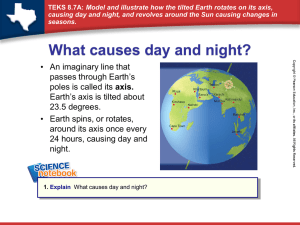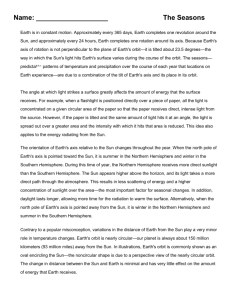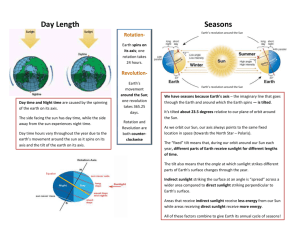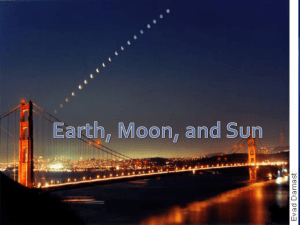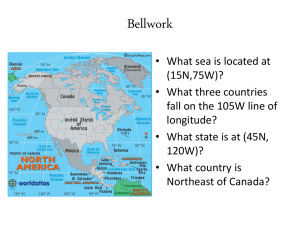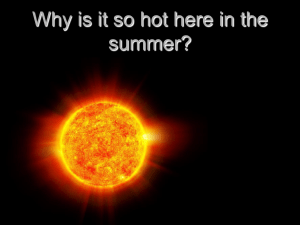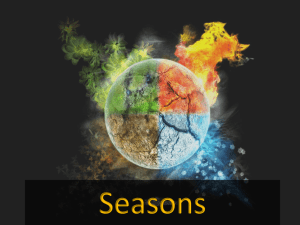Focus Lesson 1 - I-4CorridorElementaryScience
advertisement
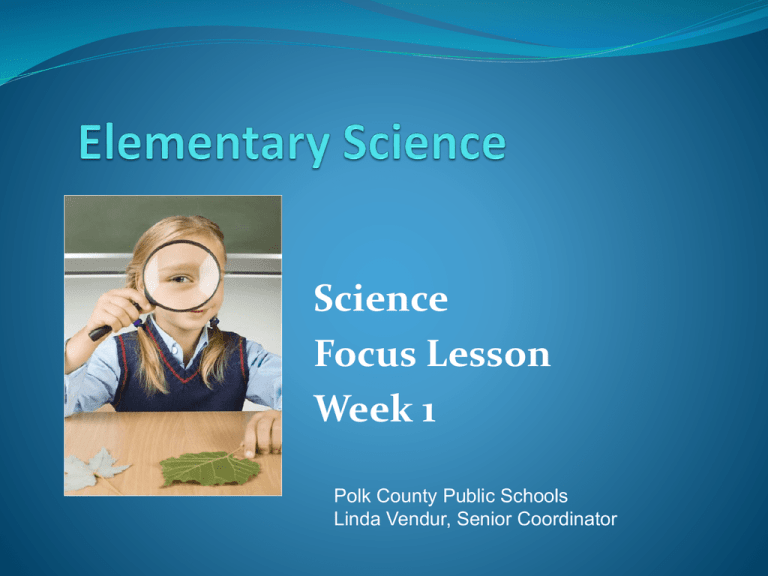
Science Focus Lesson Week 1 Polk County Public Schools Linda Vendur, Senior Coordinator Week 1 – SC.E.1.2.1 Benchmark: The student knows that the tilt of the Earth on its own axis as it rotates and revolves around the sun cause changes in season, length of day, and energy available. Essential Question: How does Earth’s tilt affect the Earth? Vocabulary: revolve axis tilt southern hemisphere northern hemisphere rotate http://www.windows.ucar.edu/tour/link=/earth/climate/cli_seasons.html SC.E.1.2.1 Effect of Earth’s Tilt Earth is tilted on its axis and revolves around the sun. • Tilted 23 ½ degrees •Revolution is 365 ¼ days (1 year) Different amounts of sunlight reach different parts of Earth during the year. • Longer and Different seasons in different parts of Earth shorter days • Indirect and direct light Cause and Effect Relationship • Seasons are opposite in the Northern Hemisphere and the Southern Hemisphere. Summarizing In your Science notebook write what you learned today. Today I learned… What would be the season in the Northern Hemisphere? Why? N Sun’s Rays S What would be the season in the Southern Hemisphere? Why? How would you group these words? Explain how they are related. Summarizing Draw a picture in your Science notebook to show the position of the sun and the Earth when the northern hemisphere is having winter. Keisha knows that Earth rotates on its axis. What evidence indicates Earth is rotating on its axis? A. There is a day and a night. B. There are 365 days in each year. C. There are four phases of the Moon. D. There are different seasons of the year. Keisha knows that Earth rotates on its axis. What evidence indicates Earth is rotating on its axis? A. There is a day and a night. When you see “rotating” in the question that is a clue that the answer will have to do with day and night. B. There are 365 days in each year. C. There are four phases of the Moon. D. There are different seasons of the year. In regions near the North and South Poles, the Sun does not set for several months in the summer. These areas, such as the northern parts of Alaska and Norway, are called the “land of the midnight Sun,” because the Sun remains visible for 24 hours a day. Why is the Sun visible for so many hours during the day? Explain your answer. 0, 1 or 2 Score your answer Sample of Correct and Complete Response Earth tilts as it moves around the Sun. If the North Pole is tilted toward the Sun, it will be sunny all the time at the North Pole. The South Pole will be dark all the time because it is tilted away from the sun. Summarizing Answer the Essential Question in your Science notebook. Essential Question: How does the Earth’s tilt affect the Earth? Check Your Understanding 1. Which of the following happens because of the tilt of Earth’s axis? A. B. C. D. day and night solar eclipse lunar eclipse’ seasons 2. During the month of December, it is very warm in the Southern Hemisphere. Which of the following explains why the Southern Hemisphere receives more energy from the sun during December than it receives during other months? A. Earth is rotating on its axis. B. Earth’s Southern Hemisphere is tilted toward the sun. C. Earth’s Northern Hemisphere is tilted toward the sun. D. The Earth is rotating on its axis. 3. On March 20 or March 21 each year, the Northern Hemisphere has twelve hours of daylight and twelve hours of darkness. Which of the following explains why this happens? A. Earth revolves around the sun. B. Earth is the center of the solar system. C. Earth rotates on a tilted axis. D. Earth moves closer to the sun. 4. Ashley’s science group is doing a report on the Sun’s energy and Earth. Ashley is asked to explain to the class why it is cold at the North and South Poles and hot at the equator. How could she explain this using a globe of the Earth and a flashlight? Check Your Answers 1. D. Seasons 2. B. Earth’s Southern Hemisphere is tilted toward the sun. 3. C. Earth rotates on a tilted axis. 4. See next slide for answer 0, 1 or 2 Score your answer An explanation similar to the following scored 2 points. She could explain by shining a flashlight at a globe near the equator. The flashlight will be the Sun’s ray. Not much light will reach the poles so not much heat will reach the poles either. Therefore it is colder at the poles than at the Equator. Summarizing Write in your Science notebook… 3 reasons we have seasons 2 words that describe Earth’s movement 1 cause of day and night
